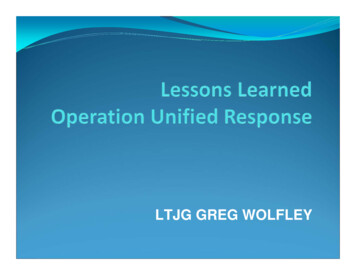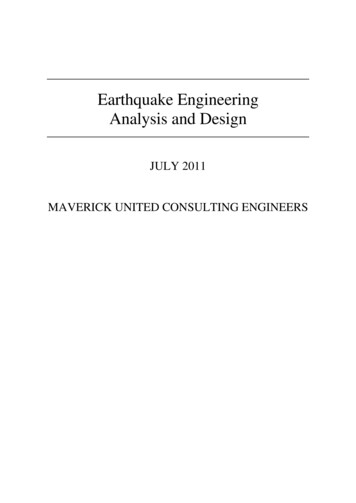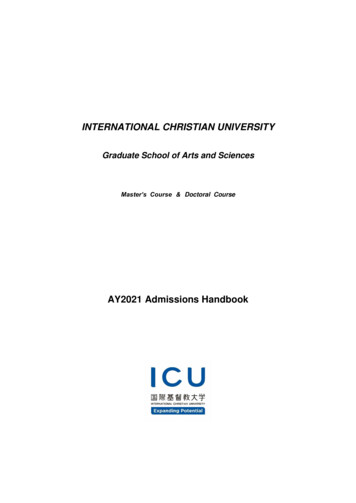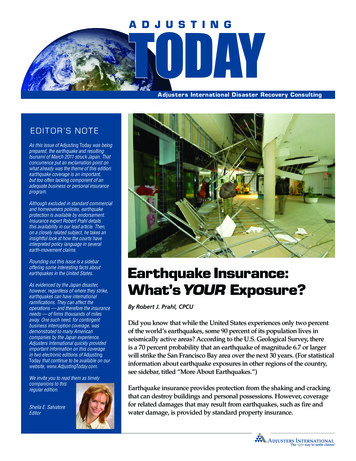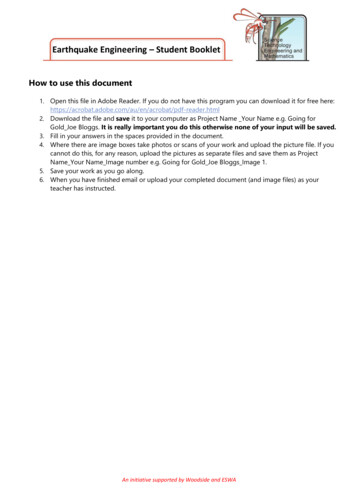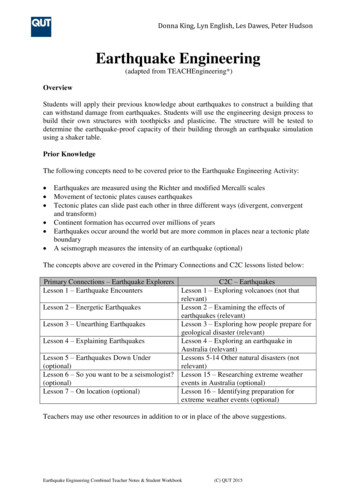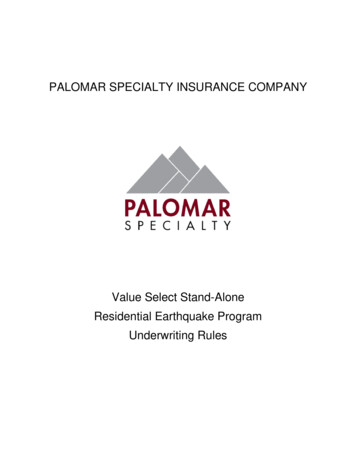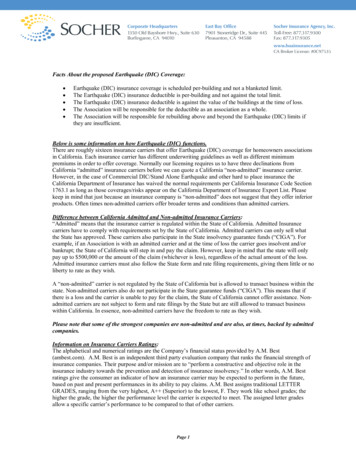
Transcription
Facts About the proposed Earthquake (DIC) Coverage: Earthquake (DIC) insurance coverage is scheduled per-building and not a blanketed limit.The Earthquake (DIC) insurance deductible is per-building and not against the total limit.The Earthquake (DIC) insurance deductible is against the value of the buildings at the time of loss.The Association will be responsible for the deductible as an association as a whole.The Association will be responsible for rebuilding above and beyond the Earthquake (DIC) limits ifthey are insufficient.Below is some information on how Earthquake (DIC) functions.There are roughly sixteen insurance carriers that offer Earthquake (DIC) coverage for homeowners associationsin California. Each insurance carrier has different underwriting guidelines as well as different minimumpremiums in order to offer coverage. Normally our licensing requires us to have three declinations fromCalifornia “admitted” insurance carriers before we can quote a California “non-admitted” insurance carrier.However, in the case of Commercial DIC/Stand Alone Earthquake and other hard to place insurance theCalifornia Department of Insurance has waived the normal requirements per California Insurance Code Section1763.1 as long as those coverages/risks appear on the California Department of Insurance Export List. Pleasekeep in mind that just because an insurance company is “non-admitted” does not suggest that they offer inferiorproducts. Often times non-admitted carriers offer broader terms and conditions than admitted carriers.Difference between California Admitted and Non-admitted Insurance Carriers:“Admitted” means that the insurance carrier is regulated within the State of California. Admitted Insurancecarriers have to comply with requirements set by the State of California. Admitted carriers can only sell whatthe State has approved. These carriers also participate in the State insolvency guarantee funds (“CIGA”). Forexample, if an Association is with an admitted carrier and at the time of loss the carrier goes insolvent and/orbankrupt; the State of California will step in and pay the claim. However, keep in mind that the state will onlypay up to 500,000 or the amount of the claim (whichever is less), regardless of the actual amount of the loss.Admitted insurance carriers must also follow the State form and rate filing requirements, giving them little or noliberty to rate as they wish.A “non-admitted” carrier is not regulated by the State of California but is allowed to transact business within thestate. Non-admitted carriers also do not participate in the State guarantee funds (“CIGA”). This means that ifthere is a loss and the carrier is unable to pay for the claim, the State of California cannot offer assistance. Nonadmitted carriers are not subject to form and rate filings by the State but are still allowed to transact businesswithin California. In essence, non-admitted carriers have the freedom to rate as they wish.Please note that some of the strongest companies are non-admitted and are also, at times, backed by admittedcompanies.Information on Insurance Carriers Ratings:The alphabetical and numerical ratings are the Company’s financial status provided by A.M. Best(ambest.com). A.M. Best is an independent third party evaluation company that ranks the financial strength ofinsurance companies. Their purpose and/or mission are to “perform a constructive and objective role in theinsurance industry towards the prevention and detection of insurance insolvency.” In other words, A.M. Bestratings give the consumer an indicator of how an insurance carrier may be expected to perform in the future,based on past and present performances in its ability to pay claims. A.M. Best assigns traditional LETTERGRADES, ranging from the very highest, A (Superior) to the lowest, F. They work like school grades; thehigher the grade, the higher the performance level the carrier is expected to meet. The assigned letter gradesallow a specific carrier’s performance to be compared to that of other carriers.Page 1
A.M. Best also assigns NUMBER GRADES to express a carrier’s financial size. This is also referred to as theFinancial Size Category (FSC). The financial size category is an indicator of how much capital, surplus andconditional reserve funds the carrier has. Financial size categories range from 1 (“I”) to 15 (“XV”); 1 (“I”)represents the lowest financial reserves and 15 (“XV”) represents the highest. Many associations prefer buyingcoverage from companies that they believe have sufficient financial capacity to insure their risk.How Earthquake (DIC) Insurance Coverage is Different From Property Insurance:The majority of homeowners associations that require building coverage have multiple buildings. InsuranceAgents and Brokers must report a limit for each building to the insurance carriers in order for the insurancecarrier to offer coverage. The Property insurance carriers add a blanketed limit endorsement that adds up all ofthe multiple buildings as one limit. Earthquake (DIC) insurance carriers do not offer a blanketed limitendorsement; therefore coverage is provided on a schedule limit per-building basis.Example: An association consists of 5 buildings that we valued at 1,000,000 each. The total limit of insurancefor the insurance policy is 5,000,000; however the maximum the insurance carrier will pay at the time of lossis 1,000,000 per-building, minus the per-building deductible.Please note: If the buildings cost more to re-build than the reported (scheduled) limit, then the Association willbe responsible that amount.How the Per-Building Deductible Works:The carriers determine the deductible amount based on a per building basis, please see the example below.Example: An association consists of 5 buildings that we valued at 1,000,000 each. If an earthquake collapsestwo of the buildings, the deductible per-building, at 20%, is 200,000 for each building.Please note: The deductible may be applied against the total insurable values of the buildings at the time of lossand not against the reported building schedule on file with the insurance carrier.How the Unit Owners Can Protect Themselves at the Time of Loss: Purchase a personal lines Earthquake insurance policy.Make sure the policy has coverage for: interior structure (“real property”), personal contents,loss of use, building code upgrades, and earthquake loss assessment.This coverage can be purchase by your personal lines insurance agent. Two personal lines Earthquakeinsurance programs that we are aware are: the California Earthquake Authority(www.earthquakeauthority.com) and Geovera Insurance Company (www.quakebroker.com).There are other personal lines Earthquake insurance carriers that offer personal earthquake insurancecoverage.Page 2
BETH A. GRIMM. P.L.C.3478 Buskirk Ave., Ste. 1000Pleasant Hill, CA 94523Ph. 925 746-7177Fax 925 215-8454Web: http://www.californiacondoguru.comEARTHQUAKE INSURANCE - TO BUY OR NOT TO BUY - THAT IS THEQUESTION!by Beth A. Grimm, Esq.Many community associations have been inquiring whether they should buy earthquake insurance,considering that the costs have become exorbitant. After networking with attorneys all over the stateof California that had to deal with the problems involving reconstruction, collection of special assessments,and disputes with insurance companies in the aftermath of the Loma Prieta and Northridge quakes, it is myopinion that associations should purchase earthquake insurance if they can get it, even if the price is high.The reason: Associations that DID NOT have coverage experienced severely exacerbated problems.Translated into English - the Associations that did not have coverage had a much harder time recovering.Many still have not recovered - and it is years later. The homeowners who wish to rebuild and keep theirhomes are the biggest losers when there is no insurance and the special assessment to rebuild is out ofreach of the average person.I have been asked since to speak to many associations about the considerations behind the decision to buyor not to buy - and have shared the floor with insurance representatives that are able to find earthquakeinsurance, some even with a 10 percent deductible, a "per building" deductible (which is more desirablethan a "per development" deductible) for a sum of money that is sufficiently affordable. By the way, myrule of thumb in 1996-2001 was that I considered an affordable master policy to be somewhere in the rangeof 400.00 - 600.00 per year per unit for homes priced in the neighborhood of 200,000.00. With risingvalues and considering a median statewide market value of a home worth about 500,000- 1,000,000 invalue, and rising insurance costs since then, I would consider protection in the range of 1000- 1500 perhome per year to be affordable and worthwhile for the EQ coverage. I base this on what I am willing to payto get the coverage, given the property I own (which includes a condo on or near a fault). A board has totake into consideration the interests of the community and not make decisions based on individual interests.Many boards, when they face the increases coming through for earthquake insurance and the cuts incoverage, immediately react with negativity, and their objectivity is lost, because it just seems unfair.Maybe it is unfair - life is not always fair. But it is extremely important to consider the risks involved insaying "NO".Those risks are:
If there is an earthquake, the board members and association could be sued and the directors andofficers liability carrier may deny coverage for "failure to adequately insure".This "failure" is an excluded item on most directors and officers liability coverage policies. Even though theredoes not seem to be a binding precedent yet - many of the insurance companies are publicly claiming that theycould assert this exclusion as a basis to deny a claim if an association or board was sued for failure to purchaseearthquake insurance. If the association has no coverage, and there is an earthquake, only those owners with substantial equityin their property will be inclined to stay and weather the special assessments needed to reconstruct.In many cases, we could easily be talking about the difference in a 25,000 to 50,000 assessment in anassociation that has master earthquake coverage as opposed to a 250,000 - 500,000 assessment in anassociation that does not (based on discussion about homes that average 500,000 in cost, maybe a scarcitytoday). If any owner cannot withstand the payments on an SBA loan (the most chosen loan of choice afterNorthridge) and that person walks away from the property, the others may have to pick up the difference, so-tospeak. So favoring EQ insurance even if You could withstand the total rebuild cost does not help your neighborwho lives "on the fringe." "Stand alone" coverage which is purportedly being offered for individual homeowners whoseassociations are uninsured is not a very practical solution, considering how difficult it would be torebuild one single unit in a four, five or six unit building. (Besides, reportedly, the quotes given toowners are astronomical, and some policies sold purportedly as “stand-alone” products will only pay ifthere is underlying coverage, and this kind of coverage may not even be offered as the threat ofearthquakes is assessed and reassessed and the insuranceIf your CC&Rs require that the board purchase earthquake insurance coverage, then it is my opinion that itmust be purchased unless the CC&Rs are amended. If it is not, then there is a problem in ignoring thegoverning documents and they should be amended.For any association that is having difficulty getting earthquake insurance or that is having difficultyjustifying the cost and is considering just saying "NO", the following [minimal] steps should be taken inorder to enable the board to claim the decision was a "prudent business decision" and protect theAssociation, and themselves.The board of directors should investigate as follows: Obtain risk analysis for type of development and geological location.Procure multiple bids from insurance companies for earthquake insurance, or from insurance brokerwho has access to several different companies.Survey homeowners to see where they stand on the issue (providing them with meaningful facts andinformation the board has gathered).Determine whether the costs involved would require homeowner approval (if they are in excess oflegal limits for increases in regular assessments or imposing a special assessment).
Make a prudent decision after gathering and considering the information as described above.If the association wants to purchase earthquake insurance and the costs exceed legal limits for increases,then the association must go to the membership to get approval of a majority of a quorum of thehomeowners for the special assessment or the increase in regular assessments to cover the insurance costsunder Civil Code Section 1366 (the governing documents may require majority approval for the purchase –or there may be extenuating circumstances that lead to a decision to borrow from the reserves or consideran emergency assessment for an increase that could not be anticipated in the budget process, so be sure toget legal advice on this). For those associations waiting for a state program to bail you out, you can stopwaiting. The California Earthquake Authority, and any other state program selling residential insurancepolicies, will not provide coverage for associations because associations must purchase commercialinsurance. This is not to say that it is a dead issue. We keep asking, and the CEA is in the discussions aboutthe quandary for HOA of difficult to what seem impossible premiums for minimal protections.Community/Homeowner associations are considered a business by the insurance world. Owners canpurchase coverage there on an individual basis, but there are no master association policies availablethrough the CEA, currently. And the availability of insurance to homeowners may be conditioned upon theAssociation providing coverage in many cases, even with the CEA.Some associations are considering using the money that would otherwise be used to purchase earthquakeinsurance for retrofitting. If your buildings could benefit greatly from retrofitting, this might be an option.However, the above considerations still apply. Perhaps if an association must pay exorbitant amounts forlayers of insurance to get full protection, there might be a feasible way to combine the purchase of minimalcoverage with additional monies being spent on retrofitting.It is best to consult with your (knowledgeable, I hope) legal counsel and seriously discuss the legalramifications, and consult with a knowledgeable insurance agent to discuss the options available, beforeturning your back on the question involving the purchase of earthquake insurance.By Beth A. Grimm, Attorney. A member of the Bay Area-Central CAI Chapter and (former) PublicRelations Chair of CAI’s California Legislative Action Committee (CLAC), ECHO East Bay ResourcePanel Member (and former Chairperson), and author of FINDING THE KEY TO YOUR CASTLE and otherhelpful community association publications. Visit www.californiacondoguru.com for more freeinformation.
In the Event of An EQ Are You Willing to Walk Away From Your Home Lose Your Investment?I will say it again: In the Event of An EQ - Are You Willing To Walk Away From Your Home - LoseYour Investment? How about this: Are you willing to force others out of their homes? If you are on theboard, do you want to set your association up for failure in the event of a big earthquake? Do youwant to let those with little invested in their homes dictate the level of protection of property for everyonein the development? Would you adopt the “Chicken Little " philosophy (“the sky is falling in so why botherplanting the seeds”)?Think about it. Certainly, if there is a devastating earthquake and your association is downed, that wouldbe a very bad thing, but that does not mean the world is coming to an end. What is left are owners thatneed a solution. Certainly, there would be serious repercussions. The question is: is there going to be achance that your members will be able to support rebuilding? And: What are you going to do to tryand make sure it is within the realm of possibility that your association can rebuild?If you are not willing to look at the possibilities, you can always throw your hands up and say - “if there isa big earthquake we are all cooked! So why try?” This is the “Chicken Little” philosophy.I am in favor of the former, which is, looking at all options, and presenting all options to the members ofthe Association. I believe that Boards should look past the rising premiums and the lowered coverageaspects - painful as it might be - get above the anger with the insurance companies for doing this, and thedisdain for the messengers (agents and brokers) who are scrambling to find you coverage, and get onwith a plan to succeed if there is a big earthquake and if it hits your community hard.Looking forward, and backward for that matter, if there is/was an EQ centered in your community, and itdevastates your association, and others within a reasonably small radius, the Chicken Little "world isfalling in" theorizing will/will have buried you. There will be heck to pay, lawsuits and pointing fingers allover the place. Few will think back that the 500, 1000 or 2000 that each owner would have had to payfor a year of some very basic protection was too heavy a price to pay.And think about this too: even if the governing documents do not require the purchase of earthquakeinsurance, they do require that the board take measures to protect and preserve the property values.What can be more graphic a misstep than allowing the EQ to lapse, suffering EQ damage, and finding theproperty values are in the dumps?This is why Boards need to take great pains to make sure that owners understand the ramifications ofletting all EQ insurance go. There are various layers of coverage that can be considered to save money,and as layers are added, the price goes down. Individual owners can get protection through the CEA forup to 50,000 in loss assessment coverage for any special assessment they might have to pay in theevent of an EQ event. If you as a Board tell owners they can get the coverage, and you take it a stepfurther and calculate the amount of protection owners could get by multiplying the number of owners inyour association by 50,000, you can realistically look at a reasonable deductible that may be higher thananything you have considered acceptable in the past. If 100 owners got the CEA coverage in your
association, that is 5,000,000 worth of coverage (by my math) and encouraging this practice could allowraising the deductible, which could save some dollars.It's a tough decision, purchasing earthquake insurance, or any insurance for that matter, as it seems likemoney gone into the wind, if there is no "event". But if we buck up and pay now, we may not have to pay100 times over later on. Betting against yourself may seem a waste, but to me, the fact that suchinsurance still can be bought is a blessing in disguise. Some of the wind and flood damaged areas of thecountry no longer offer any of this kind of "sleep-at-night" protection at all.You can read more on this subject including an article entitled "Earthquake Insurance - To Buy or Not toBuy - That is the Question," by visiting my web site (see below).Beth A. Grimm is an attorney who serves homeowner associations and homeowners alike. She is afrequent contributor to the Echo Journal and other similar publications in the State of California and on anational level. She is provides several publications written in plain English to help people who informationabout California law as it relates to homeowner associations. She posts a wealth of information on herweb site at californiacondoguru.com.Copyright 2007 Beth A. Grimm, All Rights Reserved
(www.earthquakeauthority.com) and Geovera Insurance Company (www.quakebroker.com). There are other personal lines Earthquake insurance carriers that offer personal earthquake insurance coverage. BETH A. GRIMM. P.L.C. 3478 Buskirk Ave., Ste. 1000 Pleasant Hill, CA 94523


